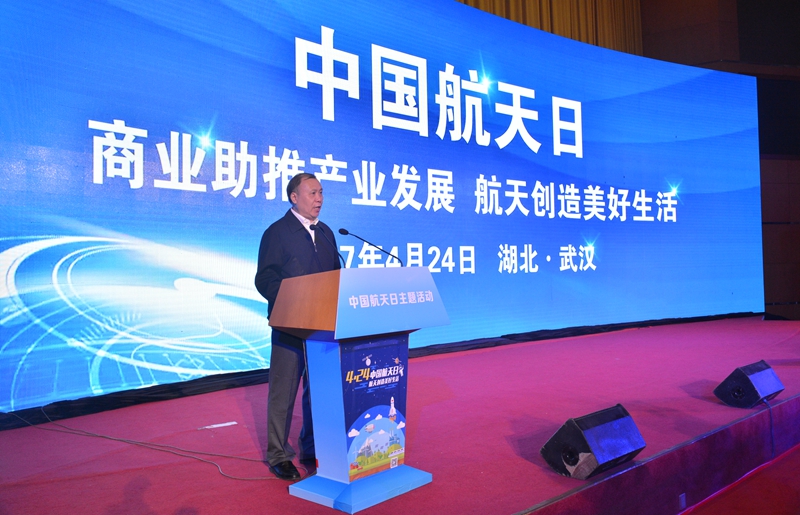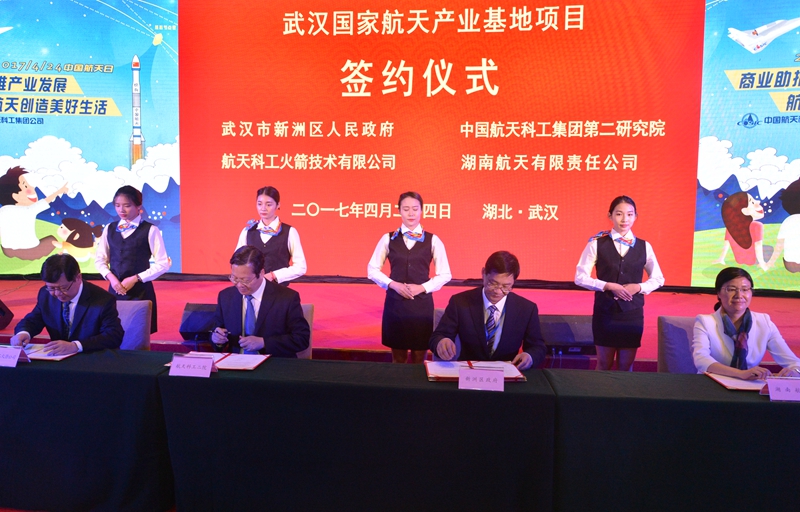
- A
- A
- A

As theme activity of the second China Space Day, on April 24, the commercial aerospace industry of CASIC released various new progress in Wuhan: the construction of the Wuhan National Aerospace Industry Base officially commenced in Xinzhou district, and CASIC Rocket Technology Co., Ltd. has moved into the base; the KZ-1A solid launch vehicle obtained 4 launch service contracts in one deal, and 4 satellites are planned to be launched within one week next year, realizing quick deployment of remote-sensing satellites.

Gao Hongwei, the Secretary of Party Committee and the Chairman of CASIC, Song Xin, a member of Party Committe and a vice President of CASIC, Zhou Xianwang, a vice governor of Hubei, and Wan Yong, the mayor of Wuhan made an on-site survey in the base and presided the project cooperation signing ceremony. 2nd Academy of CASIC, CASIC Rocket Technology Co., Ltd. and Hunan Aerospace and Expace signed cooperation agreements for relevant projects with the government of Xinzhou District of Wuhan City.
2nd Academy of CASIC registered a CASIC Space Engineering Development Co., Ltd. with registered capital of RMB 0.3 billion, and the new company officially started commercial aerospace projects such as Hongyun Project and etc. CASIC Rocket Technology Co., Ltd. will focus on the launch vehicle assembly and commissioning center project, invest RMB 1.7 billion in the first stage of the project and form assembly test and test capability for 20 launch vehicles. Hunan Aerospace Co., Ltd. Will build a scientific research and production base for military-civilian integration electromagnetic protection materials and special soft magnetic. In 2020, the base is planning to realize operation revenue of RMB 1 billion.
The government of Xinzhou District will study and implement supporting preferential policies and start the construction of auxiliary facilities. In order to ensure smooth cooperation, both parties will establish the mechanism of exchange visits of officers and communication and establish project negotiation and communication mechanism, and ensure the smooth progress of all work items in the base.
On August 15, 2016, the Implementation Plan of Wuhan National Aerospace Industrial Base is officially approved by the National Development and Reform Commission of China (NDRC). The planned area in the plan is about 103200mu (68.8 square kilometer), and the core area (area: 11800mu) of it is the Shuangliu base of Xin Zhou District of Wuhan By constructing the industry base, CASIC will strive to forge a national commercial space flight high-tech industry base, national commercial space flight technology innovation and entrepreneur base and national commercial space flight development communication center in Wuhan along with all parties, revealing an pivotal strength for the development of space flight of China.
The construction project of CASIC Xingyun, Hongyun, Kuaiyun, Feiyun, cargo returning capsule of space station, space new material test lab, new materials, industrial Internet, big data and etc. will commenced in the base. The base will deploy four parks including the rocket industry park, satellite industry park, drone industry park and new material industry park, build a commercial aerospace industry group that features a complete system and characteristics. It is estimated that, at the end of the 13th Five-Year Plan, there will be 100 -150 enterprises stationed in the base, amassing annual output value of RMB 30 billion.
According to relevant cooperation agreements, Wuhan National Space Industry Base will be implemented in the mode of “joint construction of industries and the new town”. Wuhan Municipal Government will entrust a third party to fund the infrastructure construction of the base so as to provide convenient, high efficient and high quality one-stop service for enterprises to be settled down in the base and ensure the “fully furnished” settlement of the enterprises.

In the last China Space Day, the KZ-1A developed by 4th Academy of CASIC received launch orders, and CASIC successfully managed to complete the launch contract within 8 and a half months. Receiving 4 rocket launch orders in one deal proves that the KZ series launch vehicle has entered the mass production and launch stage, significantly lowering production and launch cost.
According to the introduction made by responsible person of CASIC, in order to provide faster, better and cheaper “one-stop” service for customers of small satellites and microsatellites all over the world, 4th Academy created the “KZ” mode of commercial space launching service in the Internet era - widely absorbing social capitals and markets to participate into the whole process from the R&D of launch vehicles to the launching service, and simplifying the circulation links, so as to improve the reliability and the cost performance of the launch vehicles.
Except for industry base construction and R&D of commercial aerospace model product, CASIC introduces social capitals, explores new approach for the capitalization of research input, and creates new modes for commercial space projects according to the development mode of “Mobilizing the wits of whole society in the development of overall design institute, overall design department and final assembly plant”. 4th Academy of CASIC, together with Hubei Yangtze River Economic Zone Industry Guide Fund, Wuhan municipal government investment platform and other social capitals, set up the Yangtze River Aerospace Fund with the total scale of RMB 10 billion. The initial financing capital of RMB 2.58 billion has been fully funded. The Fund will take commercial space, military and civilian integration, mass entrepreneurship and innovation, reform toward mixed system, and merger and acquisition as the main investment directions and carry out investment mainly around Wuhan National Space Industry Base and the Yangtze River Economic Zone.
According to introduction, the development of KZ-11 rocket that can carry 5 times the loading capacity of KZ-1A, progresses smoothly and it will be launched at the end of the year. The demonstration and key technology problems tackling for “KZ-21” with larger carrying capacity have been started. “KZ-1A”, “KZ-11” and “KZ-21” are enriching the launch vehicle family for CASIC commercial launching.
(Reported by Ni Wei and Chen Xinyong, Photographed by Pei Shiwei)




